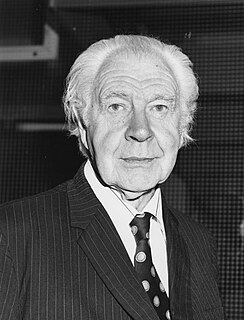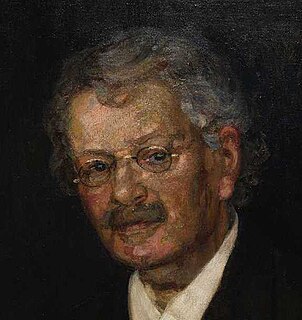Neoclassical economics is an approach to economics focusing on the determination of goods, outputs, and income distributions in markets through supply and demand. This determination is often mediated through a hypothesized maximization of utility by income-constrained individuals and of profits by firms facing production costs and employing available information and factors of production, in accordance with rational choice theory, a theory that has come under considerable question in recent years.
In economics, general equilibrium theory attempts to explain the behavior of supply, demand, and prices in a whole economy with several or many interacting markets, by seeking to prove that the interaction of demand and supply will result in an overall general equilibrium. General equilibrium theory contrasts to the theory of partial equilibrium, which only analyzes single markets.

Lionel Charles Robbins, Baron Robbins, was a British economist, and prominent member of the economics department at the London School of Economics. He is known for his leadership at LSE, his proposed definition of economics, and for his instrumental efforts in shifting Anglo-Saxon economics from its Marshallian direction. He is famous for the quote, "Humans want what they can't have."

Gérard Debreu was a French-born economist and mathematician. Best known as a professor of economics at the University of California, Berkeley, where he began work in 1962, he won the 1983 Nobel Memorial Prize in Economic Sciences.

Antoine Augustin Cournot was a French philosopher and mathematician who also contributed to the development of economics.

Johan Gustaf Knut Wicksell was a leading Swedish economist of the Stockholm school. His economic contributions would influence both the Keynesian and Austrian schools of economic thought. He was married to the noted feminist Anna Bugge.

Michio Morishima was a Japanese economist, mathematician and econometrician, who was a faculty member at the London School of Economics from 1970–88 as the Sir John Hicks Professor of Economics. He was also emeritus professor of Osaka University and a member of the British Academy.
Monetary disequilibrium theory is a product of the monetarist school and is mainly represented in the works of Leland Yeager and Austrian macroeconomics. The basic concepts of monetary equilibrium and disequilibrium were, however, defined in terms of an individual's demand for cash balance by Mises (1912) in his Theory of Money and Credit.
A Walrasian auction, introduced by Léon Walras, is a type of simultaneous auction where each agent calculates its demand for the good at every possible price and submits this to an auctioneer. The price is then set so that the total demand across all agents equals the total amount of the good. Thus, a Walrasian auction perfectly matches the supply and the demand.
Walras's law is a principle in general equilibrium theory asserting that budget constraints imply that the values of excess demand must sum to zero. That is:
The Lange model is a neoclassical economic model for a hypothetical socialist economy based on public ownership of the means of production and a trial-and-error approach to determining output targets and achieving economic equilibrium and Pareto efficiency. In this model, the state owns non-labor factors of production, and markets allocate final goods and consumer goods. The Lange model states that if all production is performed by a public body such as the state, and there is a functioning price mechanism, this economy will be Pareto-efficient, like a hypothetical market economy under perfect competition. Unlike models of capitalism, the Lange model is based on direct allocation, by directing enterprise managers to set price equal to marginal cost in order to achieve Pareto efficiency. By contrast, in a capitalist economy managers are instructed to maximize profits for private owners, while competitive pressures are relied on to indirectly lower the price to equal marginal cost.
The Lausanne School of economics, sometimes referred to as the Mathematical School, refers to the neoclassical economics school of thought surrounding Léon Walras and Vilfredo Pareto. It is named after the University of Lausanne, at which both Walras and Pareto held professorships. The central feature of the Lausanne School was its development of general equilibrium theory. Polish economist Leon Winiarski is also said to have been a member of the Lausanne School.
Applied economics is the application of economic theory and econometrics in specific settings. As one of the two sets of fields of economics, it is typically characterized by the application of the core, i.e. economic theory and econometrics, to address practical issues in a range of fields including demographic economics, labour economics, business economics, industrial organization, agricultural economics, development economics, education economics, engineering economics, financial economics, health economics, monetary economics, public economics, and economic history. The process often involves a reduction in the level of abstraction of this core theory. There are a variety of approaches including not only empirical estimation using econometrics, input-output analysis or simulations but also case studies, historical analogy and so-called common sense or the "vernacular". This range of approaches is indicative of what Roger Backhouse and Jeff Biddle argue is the ambiguous nature of the concept of applied economics. It is a concept with multiple meanings. Among broad methodological distinctions, one source places it in neither positive nor normative economics but the art of economics, glossed as "what most economists do".
David Ernest William Laidler is an economist who has been one of the foremost scholars of monetarism. He published major economics journal articles on the topic in the late 1960s and early 1970s. His book, The Demand for Money, was published in four editions from 1969 through 1993, initially setting forth the stability of the relationship between income and the demand for money and later taking into consideration the effects of legal, technological, and institutional changes on the demand for money. The book has been translated into French, Spanish, Italian, Japanese, and Chinese.
Value and Capital is a book by the British economist John Richard Hicks, published in 1939. It is considered a classic exposition of microeconomic theory. Central results include:
Mathematical economics is the application of mathematical methods to represent theories and analyze problems in economics. By convention, these applied methods are beyond simple geometry, such as differential and integral calculus, difference and differential equations, matrix algebra, mathematical programming, and other computational methods. Proponents of this approach claim that it allows the formulation of theoretical relationships with rigor, generality, and simplicity.
In economics, utility is the satisfaction or benefit derived by consuming a product; thus the marginal utility of a good or service is the change in the utility from an increase in the consumption of that good or service.
Don Patinkin was an Israeli/American monetary economist, and the president of Hebrew University in Jerusalem.

Michael Allingham is a British economist whose main work has been on equilibrium theory, choice theory, and distributive justice.







